Mass GGBFS Concrete Mixed with Recycled Aggregates as Alkali-Active Substances: Workability, Temperature History and Strength
Abstract
:1. Introduction
2. Experimental Scheme
2.1. Materials
2.2. Proportion of Concrete
2.3. Testing Procedures
2.3.1. Fresh Properties Tests
2.3.2. Temperature History
2.3.3. Compressive Strength Test
2.3.4. Rebound Number
2.3.5. Micro-Analysis
3. Results and Discussion
3.1. Fresh Properties
3.2. Temperature History
3.3. Compressive Strength
3.4. Rebound Number
3.5. Micro-Analysis
4. Conclusions
- (1)
- For fresh concrete, slump decreases with increasing GGBFS content and aggregate dosage; 75% GGBFS and recycled aggregate combination gives a 31.3% lower slump than BNN with natural aggregates. The chloride content of all specimens was less than 0.3 kg/m3.
- (2)
- The higher volume level of GGBFS replacement resulted in a significant reduction in heat of hydration compared to OPC. The combination of GGBFS and recycled aggregate showed 11.2% higher heat of hydration than BNN of natural aggregate.
- (3)
- At 28 days of age, high-volume GGBFS reduces compressive strength compared to ONN. The compressive strength at 7 days and 28 days with recycled aggregate was 33.7% and 16.3% higher than with natural aggregate when high-volume GGBFS was used as a binder.
Supplementary Materials
Author Contributions
Funding
Institutional Review Board Statement
Informed Consent Statement
Data Availability Statement
Conflicts of Interest
References
- Statista. Global Cement Production from 1995 to 2022; Statista: Hamburg, Germany, 2023. [Google Scholar]
- Nilimaa, J. Smart materials and technologies for sustainable concrete construction. Dev. Built Environ. 2023, 15, 100177. [Google Scholar] [CrossRef]
- Lu, D.; Leng, Z.; Lu, G.; Wang, D.; Huo, Y. A critical review of carbon materials engineered electrically conductive cement concrete and its potential applications. Int. J. Smart Nano Mater. 2023, 14, 189–215. [Google Scholar] [CrossRef]
- Huo, Y.; Liu, T.; Lu, D.; Han, X.; Sun, H.; Huang, J.; Ye, X.; Zhang, C.; Chen, Z.; Yang, Y. Dynamic tensile properties of steel fiber reinforced polyethylene fiber-engineered/strain-hardening cementitious composites (PE-ECC/SHCC) at high strain rate. Cem. Concr. Compos. 2023, 143, 105234. [Google Scholar] [CrossRef]
- Ritchie, H.; Roser, M. Urbanization; Our World in Data: Oxford, UK, 2018. [Google Scholar]
- Roser, M.; Ritchie, H.; Ortiz-Ospina, E.; Rodés-Guirao, L. World Population Growth; Our World in Data: Oxford, UK, 2013. [Google Scholar]
- Lu, D.; Wang, D.; Zhong, J. Highly conductive and sensitive piezoresistive cement mortar with graphene coated aggregates and carbon fiber. Cem. Concr. Compos. 2022, 134, 104731. [Google Scholar] [CrossRef]
- Lu, D.; Ma, L.P.; Zhong, J.; Tong, J.; Liu, Z.; Ren, W.; Cheng, H.M. Growing Nanocrystalline Graphene on Aggregates for Conductive and Strong Smart Cement Composites. ACS Nano 2023, 17, 3587–3597. [Google Scholar] [CrossRef] [PubMed]
- Zhang, H.; Zhang, C.; He, B.; Yi, S.; Tang, L. Recycling fine powder collected from construction and demolition wastes as partial alternatives to cement: A comprehensive analysis on effects, mechanism, cost and CO2 emission. J. Build. Eng. 2023, 71, 106507. [Google Scholar]
- Santos, T.A.; Cilla, M.S.; Ribeiro, D.V. Use of asbestos cement tile waste (ACW) as mineralizer in the production of Portland cement with low CO2 emission and lower energy consumption. J. Clean. Prod. 2022, 335, 130061. [Google Scholar] [CrossRef]
- Siauciunas, R.; Prichockiene, E.; Valancius, Z. The Influence of Mg-Impurities in Raw Materials on the Synthesis of Rankinite Clinker and the Strength of Mortar Hardening in CO2 Environment. Materials 2023, 16, 2930. [Google Scholar] [CrossRef]
- Lu, D.; Huo, Y.; Jiang, Z.; Zhong, J. Carbon nanotube polymer nanocomposites coated aggregate enabled highly conductive concrete for structural health monitoring. Carbon 2023, 206, 340–350. [Google Scholar] [CrossRef]
- Shobeiri, V.; Bennett, B.; Xie, T.; Visintin, P. Mix design optimization of concrete containing fly ash and slag for global warming potential and cost reduction. Case Stud. Constr. Mater. 2023, 18, e01832. [Google Scholar]
- Saldanha, R.B.; Caicedo, A.M.L.; de Araújo, M.T.; Filho, H.C.S.; Moncaleano, C.J.; Silva, J.P.S.; Consoli, N.C. Potential use of iron ore tailings for binder production: A life cycle assessment. Constr. Build. Mater. 2023, 365, 130008. [Google Scholar] [CrossRef]
- Ribeiro, F.B.; Nascimento, F.A.C.D.; Silva, M.A.V.D. Environmental performance analysis of railway infrastructure using life cycle assessment: Selecting pavement projects based on global warming potential impacts. J. Clean. Prod. 2022, 365, 132558. [Google Scholar]
- Darange, R.; Adesina, A.; Das, S. Feasibility study on the sustainable utilization of uncalcined clay soils as Low-Cost binders. Constr. Build. Mater. 2022, 340, 127724. [Google Scholar] [CrossRef]
- Lu, D.; Shi, X.; Zhong, J. Interfacial nano-engineering by graphene oxide to enable better utilization of silica fume in cementitious composite. J. Clean. Prod. 2022, 354, 131381. [Google Scholar] [CrossRef]
- Lu, D.; Wang, Y.; Leng, Z.; Zhong, J. Influence of ternary blended cementitious fillers in a cold mix asphalt mixture. J. Clean. Prod. 2021, 318, 128421. [Google Scholar] [CrossRef]
- Huo, Y.; Lu, D.; Wang, Z.; Liu, Y.; Chen, Z.; Yang, Y. Bending behavior of strain hardening cementitious composites based on the combined fiber-interface constitutive model. Comput. Struct. 2023, 281, 107017. [Google Scholar] [CrossRef]
- Huo, Y.; Sun, H.; Lu, D.; Chen, Z.; Yang, Y. Mechanical properties of concrete at low and ultra-low temperatures—A review. J. Infrastruct. Preserv. Resil. 2022, 3, 20. [Google Scholar] [CrossRef]
- Lu, D.; Shi, X.; Zhong, J. Interfacial bonding between graphene oxide coated carbon nanotube fiber and cement paste matrix. Cem. Concr. Compos. 2022, 134, 104802. [Google Scholar] [CrossRef]
- Lu, D.; Shi, X.; Zhong, J. Understanding the role of unzipped carbon nanotubes in cement pastes. Cem. Concr. Compos. 2022, 126, 104366. [Google Scholar] [CrossRef]
- Mousavinezhad, S.; Gonzales, G.J.; Toledo, W.K.; Garcia, J.M.; Newtson, C.M.; Allena, S. A Comprehensive Study on Non-Proprietary Ultra-High-Performance Concrete Containing Supplementary Cementitious Materials. Materials 2023, 16, 2622. [Google Scholar] [CrossRef]
- de Carvalho, T.A.; Gaspar, F.; Marques, A.C.; Mateus, A. Evaluation of the Potential of Metakaolin, Electric Arc Furnace Slag, and Biomass Fly Ash for Geopolymer Cement Compositions. Materials 2023, 16, 2741. [Google Scholar] [CrossRef] [PubMed]
- Saeed, N.M.; Omer, B.; Jamal, A.S.; Dheyaaldin, M.H. Performance of cement mortar modified with GGBFS at elevated temperatures with various w/b ratios and superplasticizer dosages. Constr. Build. Mater. 2023, 368, 130493. [Google Scholar] [CrossRef]
- Bhojaraju, C.; Mousavi, S.S.; Ouellet-Plamondon, C.M. Influence of GGBFS on corrosion resistance of cementitious composites containing graphene and graphene oxide. Cem. Concr. Compos. 2023, 135, 104836. [Google Scholar] [CrossRef]
- Shahmansouri, A.A.; Nematzadeh, M.; Behnood, A. Mechanical properties of GGBFS-based geopolymer concrete incorporating natural zeolite and silica fume with an optimum design using response surface method. J. Build. Eng. 2021, 36, 102138. [Google Scholar] [CrossRef]
- Hussain, F.; Kaur, I.; Hussain, A. Reviewing the influence of GGBFS on concrete properties. Mater. Today Proc. 2020, 32, 997–1004. [Google Scholar] [CrossRef]
- Yurt, Ü. High performance cementless composites from alkali activated GGBFS. Constr. Build. Mater. 2020, 264, 120222. [Google Scholar] [CrossRef]
- Zheng, X.; Lu, H.; You, S.; Cheng, K.; Easa, S.M.; Chen, Z.; Ma, C.; Fu, D.; Ji, T. Tensile creep behavior of Alkali-activated slag concrete incorporating lightweight aggregate. Constr. Build. Mater. 2022, 357, 129318. [Google Scholar] [CrossRef]
- Fu, Q.; Bu, M.; Zhang, Z.; Xu, W.; Yuan, Q.; Niu, D. Hydration Characteristics and Microstructure of Alkali-Activated Slag Concrete: A Review. Engineering 2023, 20, 162–179. [Google Scholar] [CrossRef]
- Huo, Y.; Sun, H.; Chen, Z.; Yang, Y. Mechanical properties and its reliability prediction of engineered/strain-hardening cementitious composites (ECC/SHCC) with different moisture contents at negative temperatures. Cem. Concr. Compos. 2022, 134, 104812. [Google Scholar] [CrossRef]
- Huang, J.; Zou, C.; Sun, D.; Yang, B.; Yan, J. Effect of recycled fine aggregates on alkali-activated slag concrete properties. Structures 2021, 30, 89–99. [Google Scholar] [CrossRef]
- Dai, X.; Aydın, S.; Yardımcı, M.Y.; Lesage, K.; De Schutter, G. Rheology and microstructure of alkali-activated slag cements produced with silica fume activator. Cem. Concr. Compos. 2022, 125, 104303. [Google Scholar] [CrossRef]
- Rakhimova, N.R.; Rakhimov, R.Z.; Naumkina, N.I.; Khuzin, A.F.; Osin, Y.N. Influence of limestone content, fineness, and composition on the properties and microstructure of alkali-activated slag cement. Cem. Concr. Compos. 2016, 72, 268–274. [Google Scholar] [CrossRef]
- Dai, X.; Aydin, S.; Yardimci, M.Y.; Qiang, R.E.N.; Lesage, K.; De Schutter, G. Rheology, early-age hydration and microstructure of alkali-activated GGBFS-Fly ash-limestone mixtures. Cem. Concr. Compos. 2021, 124, 104244. [Google Scholar] [CrossRef]
- Duve, T. Seaborne trades of fly ash and global trends of cementitious products. In Proceedings of the Third International ASHTRANS Conference, Nashville, TN, USA, 4–7 May 2015. [Google Scholar]
- Lu, D.; Shi, X.; Wong, H.S.; Jiang, Z.; Zhong, J. Graphene coated sand for smart cement composites. Constr. Build. Mater. 2022, 346, 128313. [Google Scholar] [CrossRef]
- Lu, D.; Shi, X.; Zhong, J. Nano-engineering the interfacial transition zone in cement composites with graphene oxide. Constr. Build. Mater. 2022, 356, 129284. [Google Scholar] [CrossRef]
- Lu, D.; Wang, D.; Wang, Y.; Zhong, J. Nano-engineering the interfacial transition zone between recycled concrete aggregates and fresh paste with graphene oxide. Constr. Build. Mater. 2023, 384, 131244. [Google Scholar] [CrossRef]
- Lu, D.; Zhong, J.; Yan, B.; Gong, J.; He, Z.; Zhang, G.; Song, C. Effects of Curing Conditions on the MECHANICAL and Microstructural Properties of Ultra-High-Performance Concrete (UHPC) Incorporating Iron Tailing Powder. Materials 2021, 14, 215. [Google Scholar] [CrossRef] [PubMed]
- Marinković, S.; Radonjanin, V.; Malešev, M.; Ignjatović, I. Comparative environmental assessment of natural and recycled aggregate concrete. Waste Manag. 2010, 30, 2255–2264. [Google Scholar] [CrossRef]
- Rong, X.-L.; Li, L.; Huang, W.-Y.; Dong, L.-G.; Zheng, S.-S.; Wang, F.; Lu, D.; Wang, J.-Y. Experimental investigation of the seismic resistance of RC beam–column connections after freeze–thaw cycle treatment. Eng. Struct. 2023, 290, 116330. [Google Scholar] [CrossRef]
- Rong, X.L.; Li, L.; Zheng, S.S.; Wang, F.; Huang, W.Y.; Zhang, Y.X.; Lu, D. Freeze–thaw damage model for concrete considering a nonuniform temperature field. J. Build. Eng. 2023, 72, 106747. [Google Scholar] [CrossRef]
- Gopalakrishna, B.; Dinakar, P. Mix design development of fly ash-GGBS based recycled aggregate geopolymer concrete. J. Build. Eng. 2023, 63, 105551. [Google Scholar] [CrossRef]
- Tian, Y.; Yan, X.; Zhang, M.; Lu, D.; Yang, T.; Wang, Z.; Li, W. Internal transport and corrosion behaviors of sulfate corrosion media carried by recycled aggregate in concrete. Constr. Build. Mater. 2020, 260, 120480. [Google Scholar] [CrossRef]
- Lian, S.; Meng, T.; Zhao, Y.; Liu, Z.; Zhou, X.; Ruan, S. Experimental and theoretical analyses of chloride transport in recycled concrete subjected to a cyclic drying-wetting environment. Structures 2023, 52, 1020–1034. [Google Scholar] [CrossRef]
- Deng, X.; Li, J.; Lu, Z.; Zhang, J.; Luo, K.; Niu, Y.; Hu, J.; He, K. Rheological and early hydration of cementitious material containing recycled concrete powders collected from recycled aggregates. Constr. Build. Mater. 2023, 393, 132108. [Google Scholar] [CrossRef]
- Tejas, S.; Pasla, D. Assessment of mechanical and durability properties of composite cement-based recycled aggregate concrete. Constr. Build. Mater. 2023, 387, 131620. [Google Scholar] [CrossRef]
- Li, P.; Gan, W.; Yao, G.; Huang, Q.; Zhao, R. Effect of Permeable Crystalline Materials on the Mechanical and Porosity Property of Recycled Aggregate and Recycled Aggregate Concrete. Materials 2023, 16, 4596. [Google Scholar] [CrossRef]
- Zhang, X.; Liu, X.; Fan, Y.; Yang, J. Seismic Behavior Analysis of Recycled Aggregate Concrete-Filled Square Steel Tube Frames. Materials 2023, 16, 4268. [Google Scholar] [CrossRef] [PubMed]
- Zhao, Y.; Wang, T.; Yi, W. Emergy-accounting-based comparison of carbon emissions of solid waste recycled concrete. Constr. Build. Mater. 2023, 387, 131674. [Google Scholar] [CrossRef]
- Wu, H.; Liang, C.; Zhang, Z.; Yao, P.; Wang, C.; Ma, Z. Utilizing heat treatment for making low-quality recycled aggregate into enhanced recycled aggregate, recycled cement and their fully recycled concrete. Constr. Build. Mater. 2023, 394, 132126. [Google Scholar] [CrossRef]
- Meng, T.; Yang, X.; Wei, H.; Meng, R.; Zhou, W. Study of the relationship between the water binder ratio and strength of mixed recycled aggregate concrete based on brick content. Constr. Build. Mater. 2023, 394, 132148. [Google Scholar] [CrossRef]
- Al-Luhybi, A.S.; Aziz, I.A.; Mohammad, K.I. Experimental assessment of mechanical and physical performance of latex modified concrete with fine recycled aggregate. Structures 2023, 48, 1932–1938. [Google Scholar] [CrossRef]
- Salas, A.; Chung, C.-W.; Mira, B.E. Interaction effect of recycled aggregate type, moisture state, and mixing process on the properties of high-performance concretes. Case Stud. Constr. Mater. 2023, 18, e02208. [Google Scholar]
- Gao, D.; Ji, D.; Gu, Z.; Yan, H.; Zhang, Y. Workability and mechanical properties analysis of hybrid fibers reinforced self-compacting concrete incorporating recycled aggregates based on acoustic emission technique. Structures 2023, 51, 1722–1741. [Google Scholar] [CrossRef]
- Vintimilla, C.; Etxeberria, M. Limiting the maximum fine and coarse recycled aggregates-Type A used in structural concrete. Constr. Build. Mater. 2023, 380, 131273. [Google Scholar] [CrossRef]
- Lu, D.; Cao, H.; Shen, Q.; Gong, Y.; Zhao, C.; Yan, X. Dynamic Characteristics and Chloride Resistance of Basalt and Polypropylene Fibers Reinforced Recycled Aggregate Concrete. Adv. Polym. Technol. 2020, 2020, 6029047. [Google Scholar] [CrossRef]
- Rezaei, F.; Memarzadeh, A.; Davoodi, M.-R.; Dashab, M.-A.; Nematzadeh, M. Mechanical features and durability of concrete incorporating recycled coarse aggregate and nano-silica: Experimental study, prediction, and optimization. J. Build. Eng. 2023, 73, 106715. [Google Scholar]
- Gopalakrishna, B.; Pasla, D. Development of metakaolin based high strength recycled aggregate geopolymer concrete. Constr. Build. Mater. 2023, 391, 131810. [Google Scholar] [CrossRef]
- Hou, Y.; Lux, J.; Mahieux, P.-Y.; Turcry, P.; Aït-Mokhtar, A. Evolution of microstructure and CO2 diffusion coefficient of compacted recycled aggregates during carbonation investigated by X-ray tomography. Constr. Build. Mater. 2023, 372, 130715. [Google Scholar] [CrossRef]
- Adessina, A.; Fraj, A.B.; Barthélémy, J.-F. Improvement of the compressive strength of recycled aggregate concretes and relative effects on durability properties. Constr. Build. Mater. 2023, 384, 131447. [Google Scholar] [CrossRef]
- Ma, Z.; Hu, R.; Yao, P.; Wang, C. Utilizing heat-mechanical synergistic treatment for separating concrete waste into high-quality recycled aggregate, active recycled powder and new concrete. J. Build. Eng. 2023, 68, 106161. [Google Scholar] [CrossRef]
- Hosseinzadeh, M.; Dehestani, M.; Hosseinzadeh, A. Prediction of mechanical properties of recycled aggregate fly ash concrete employing machine learning algorithms. J. Build. Eng. 2023, 76, 107006. [Google Scholar] [CrossRef]
- Parthiban, K.; Mohan, K.S.R. Influence of recycled concrete aggregates on the engineering and durability properties of alkali activated slag concrete. Constr. Build. Mater. 2017, 133, 65–72. [Google Scholar] [CrossRef]
- Lu, D.; Zhong, J. Carbon-based nanomaterials engineered cement composites: A review. J. Infrastruct. Preserv. Resil. 2022, 3, 2. [Google Scholar] [CrossRef]
- Saeed, M.K.; Rahman, M.K.; Alfawzan, M.; Basha, S.; Dahish, H.A. Recycling of date kernel powder (DKP) in mass concrete for mitigating heat generation and risk of cracking at an early age. Constr. Build. Mater. 2023, 376, 131033. [Google Scholar] [CrossRef]
- Ha, J.-H.; Jung, Y.S.; Cho, Y.-G. Thermal crack control in mass concrete structure using an automated curing system. Autom. Constr. 2014, 45, 16–24. [Google Scholar] [CrossRef]
- Chen, H.-L.; Mardmomen, S.; Leon, G. On-site measurement of heat of hydration of delivered mass concrete. Constr. Build. Mater. 2021, 269, 121246. [Google Scholar] [CrossRef]
- Chiniforush, A.A.; Gharehchaei, M.; Nezhad, A.A.; Castel, A.; Moghaddam, F.; Keyte, L.; Hocking, D.; Foster, S. Numerical simulation of risk mitigation strategies for early-age thermal cracking and DEF in concrete. Constr. Build. Mater. 2022, 322, 126478. [Google Scholar] [CrossRef]
- Rakić, J.M.; Petrović, R.D.; Radojević, V.J.; Baščarević, Z.D. Effects of selected inorganic chemical activators on properties and hydration mechanism of high volume fly ash (HVFA) binders. Constr. Build. Mater. 2023, 391, 131833. [Google Scholar] [CrossRef]
- Onuaguluchi, O.; Ratu, R.; Banthia, N. Effect of sodium sulfate activation on the early-age matrix strength and steel fiber bond in high volume fly ash (HVFA) cement mortar. Constr. Build. Mater. 2022, 341, 127808. [Google Scholar] [CrossRef]
- Tian, Y.; Lu, D.; Ma, R.; Zhang, J.; Li, W.; Yan, X. Effects of cement contents on the performance of cement asphalt emulsion mixtures with rapidly developed early-age strength. Constr. Build. Mater. 2020, 244, 118365. [Google Scholar] [CrossRef]
- Bischof, P.; Mata-Falcón, J.; Kaufmann, W. Fostering innovative and sustainable mass-market construction using digital fabrication with concrete. Cem. Concr. Res. 2022, 161, 106948. [Google Scholar] [CrossRef]
- Li, X.; Yu, Z.; Chen, K.; Deng, C.; Yu, F. Investigation of temperature development and cracking control strategies of mass concrete: A field monitoring case study. Case Stud. Constr. Mater. 2023, 18, e02144. [Google Scholar]
- Lyu, C.; Xu, M.; Lu, X.; Tian, B.; Chen, B.; Xiong, B.; Cheng, B. Research on thermal- humidity -force coupling characteristics of mass concrete structures under temperature control. Constr. Build. Mater. 2023, 398, 132540. [Google Scholar] [CrossRef]
- Liang, M.; Chang, Z.; Zhang, Y.; Cheng, H.; He, S.; Schlangen, E.; Šavija, B. Autogenous deformation induced- stress evolution in high-volume GGBFS concrete: Macro-scale behavior and micro-scale origin. Constr. Build. Mater. 2023, 370, 130663. [Google Scholar]
- Qu, F.; Li, W.; Tang, Z.; Wang, K. Property degradation of seawater sea sand cementitious mortar with GGBFS and glass fiber subjected to elevated temperatures. J. Mater. Res. Technol. 2021, 13, 366–384. [Google Scholar] [CrossRef]
- Xiong, X.; Yang, Z.; Yan, X.; Zhang, Y.; Dong, S.; Li, K.; Briseghella, B.; Marano, G.C. Mechanical properties and microstructure of engineered cementitious composites with high volume steel slag and GGBFS. Constr. Build. Mater. 2023, 398, 132512. [Google Scholar] [CrossRef]
- Topçu, İ.B. 10-High-volume ground granulated blast furnace slag (GGBFS) concrete. In Eco-Efficient Concrete; Pacheco-Torgal, F., Jalali, S., Labrincha, J., John, V.M., Eds.; Woodhead Publishing: Sawston, UK, 2013; pp. 218–240. [Google Scholar]
- Elchalakani, M.; Aly, T.; Abu-Aisheh, E. Sustainable concrete with high volume GGBFS to build Masdar City in the UAE. Case Stud. Constr. Mater. 2014, 1, 10–24. [Google Scholar] [CrossRef] [Green Version]
- Shubbar, A.A.; Jafer, H.; Abdulredha, M.; Al-Khafaji, Z.S.; Nasr, M.S.; Al Masoodi, Z.; Sadique, M. Properties of cement mortar incorporated high volume fraction of GGBFS and CKD from 1 day to 550 days. J. Build. Eng. 2020, 30, 101327. [Google Scholar] [CrossRef]
- Shen, D.; Liu, K.; Wen, C.; Shen, Y.; Jiang, G. Early-age cracking resistance of ground granulated blast furnace slag concrete. Constr. Build. Mater. 2019, 222, 278–287. [Google Scholar] [CrossRef]
- Wei, Y.; Hansen, W. Early-age strain–stress relationship and cracking behavior of slag cement mixtures subject to constant uniaxial restraint. Constr. Build. Mater. 2013, 49, 635–642. [Google Scholar] [CrossRef]
- Markandeya, A.; Shanahan, N.; Gunatilake, D.M.; Riding, K.A.; Zayed, A. Influence of slag composition on cracking potential of slag-portland cement concrete. Constr. Build. Mater. 2018, 164, 820–829. [Google Scholar] [CrossRef]
- ASTM C143/C143M; Standard Test Method for Slump of Hydraulic Cement Concrete. ASTM International: West Conshohocken, PA, USA, 2013.
- ASTM C231-09a; Standard Test Method for Air Content of Freshly Mixed Concrete by the Pressure Method. ASTM International: West Conshohocken, PA, USA, 2010.
- JGJ/T 322-2013; Technical Specification for Detection of Chloride Ion Content in Concrete. China Architecture and Building Press: Beijing, China, 2014. (In Chinese)
- ASTM C39/C39M; Standard Test Method for Compressive Strength of Cylindrical Concrete Specimens ASTM E4-Force Verification of Testing Machines. ASTM International: West Conshohocken, PA, USA, 2012.
- ASTM C805/C805M-18; Standard Test Method for Rebound Number of Hardened Concrete. ASTM International: West Conshohocken, PA, USA, 2002.
- Nilimaa, J.; Hösthagen, A.; Emborg, M. Thermal Crack Risk of Concrete Structures: Evaluation of Theoretical Models for Tunnels and Bridges. Nord. Concr. Res. 2017, 56, 55–69. [Google Scholar]
- Chen, G.; Li, S.; Zhao, Y.; Xu, Z.; Luo, X.; Gao, J. Hydration and microstructure evolution of a novel low-carbon concrete containing recycled clay brick powder and ground granulated blast furnace slag. Constr. Build. Mater. 2023, 386, 131596. [Google Scholar] [CrossRef]
- De Juan, M.S.; Gutiérrez, P.A. Study on the influence of attached mortar content on the properties of recycled concrete aggregate. Constr. Build. Mater. 2009, 23, 872–877. [Google Scholar] [CrossRef]
- Merlet, J.; Pimienta, P. Mechanical and physico-chemical properties of concrete produced with coarse and fine recycled concrete aggregates. In RILEM Proceedings; Chapman & Hall: London, UK, 1993; p. 343. [Google Scholar]
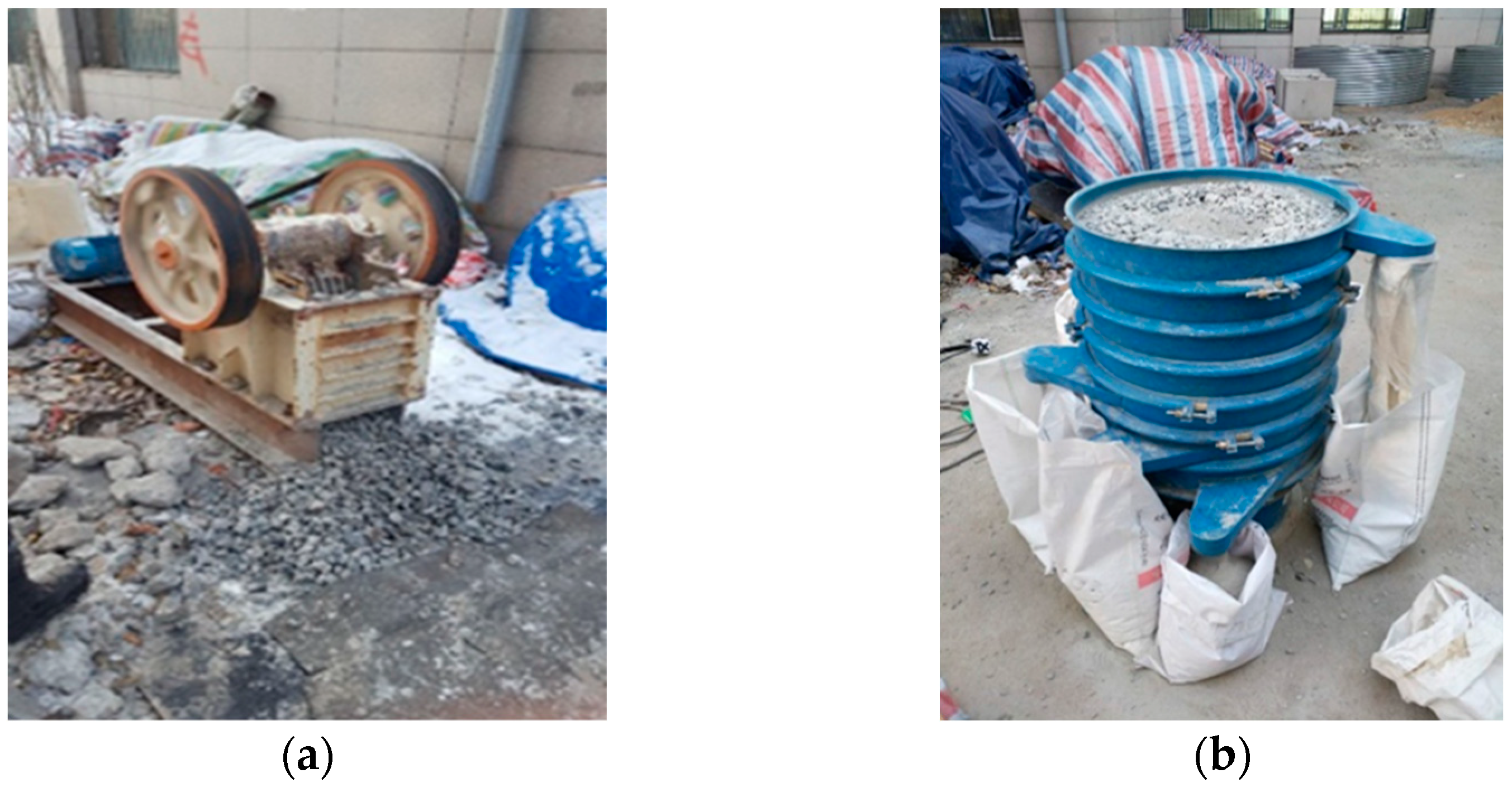
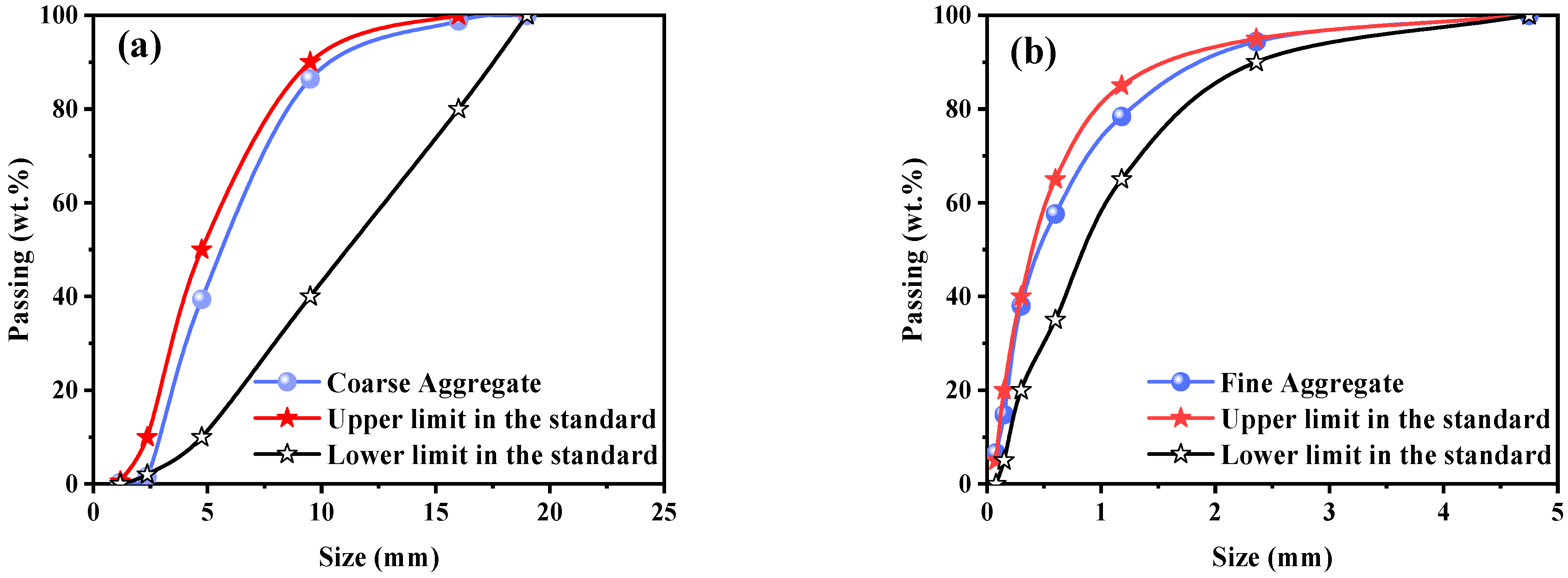
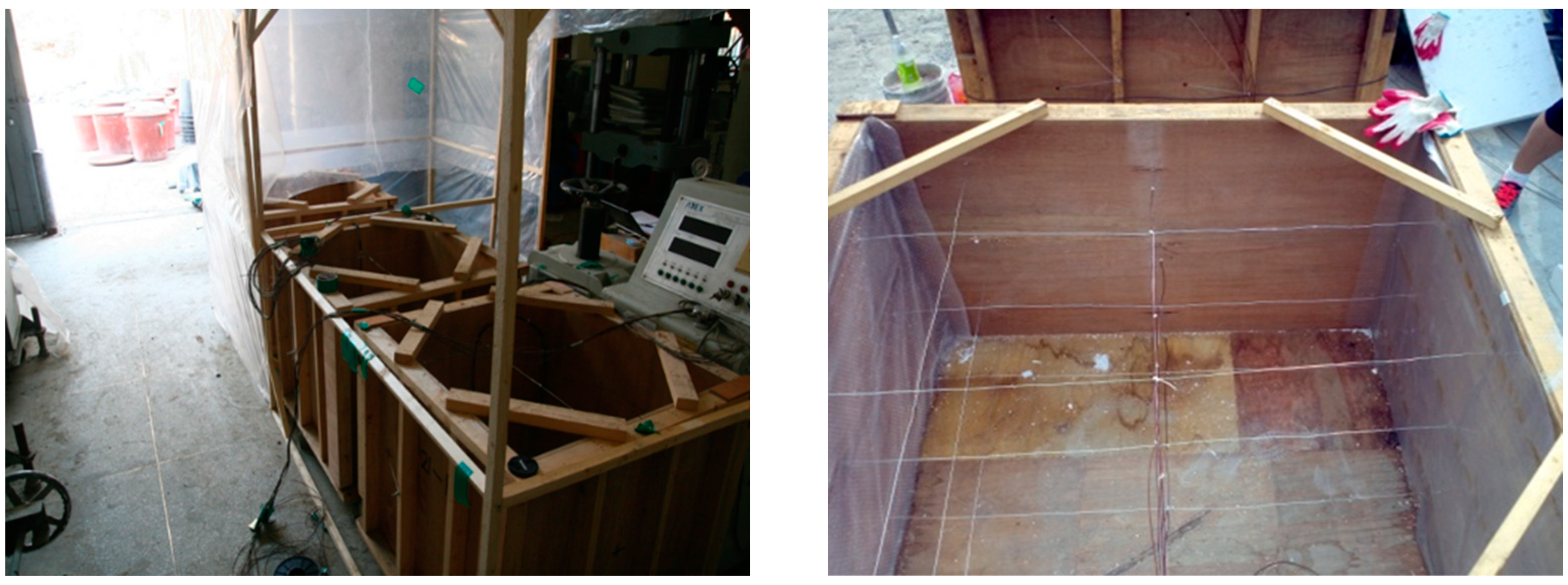
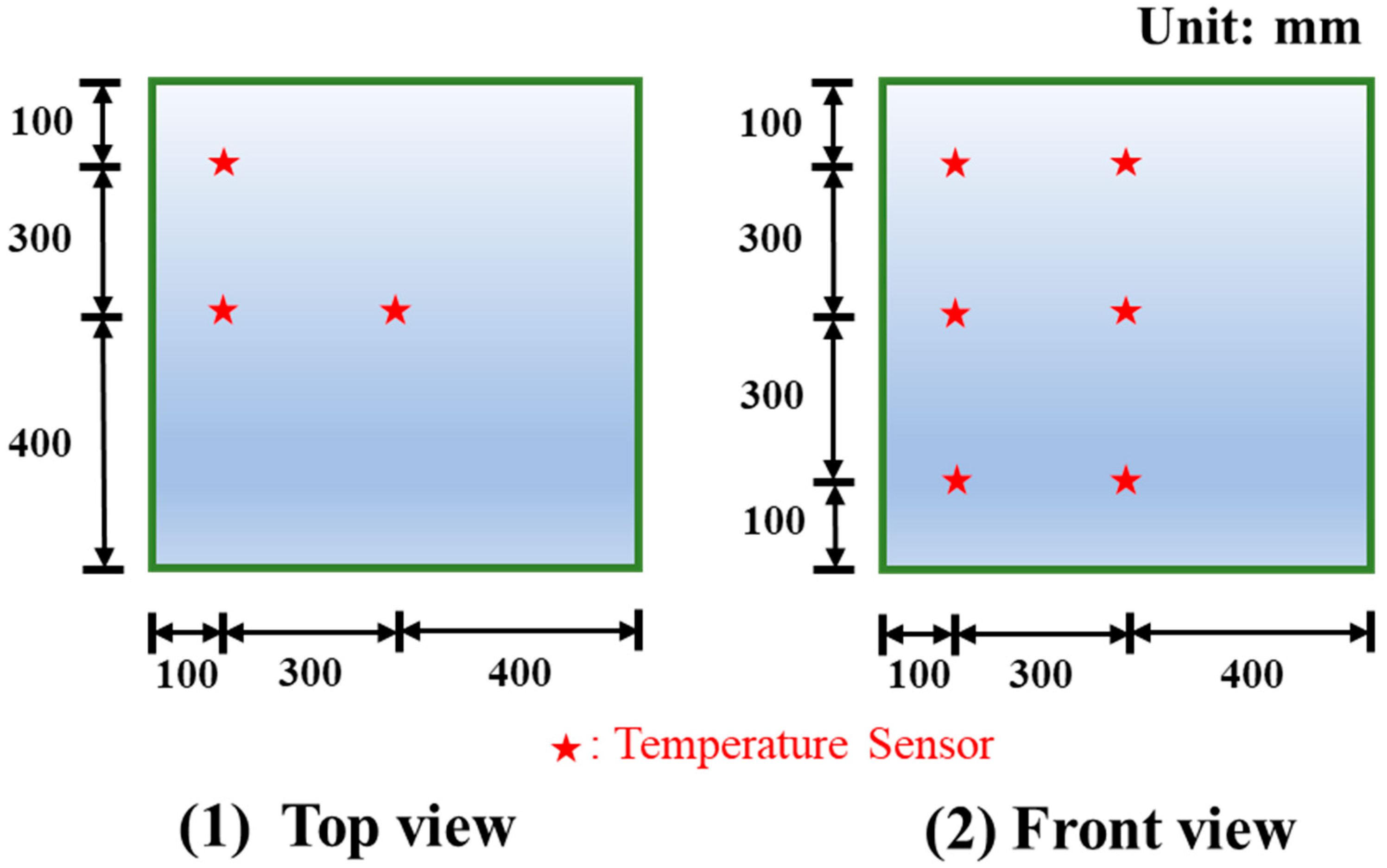
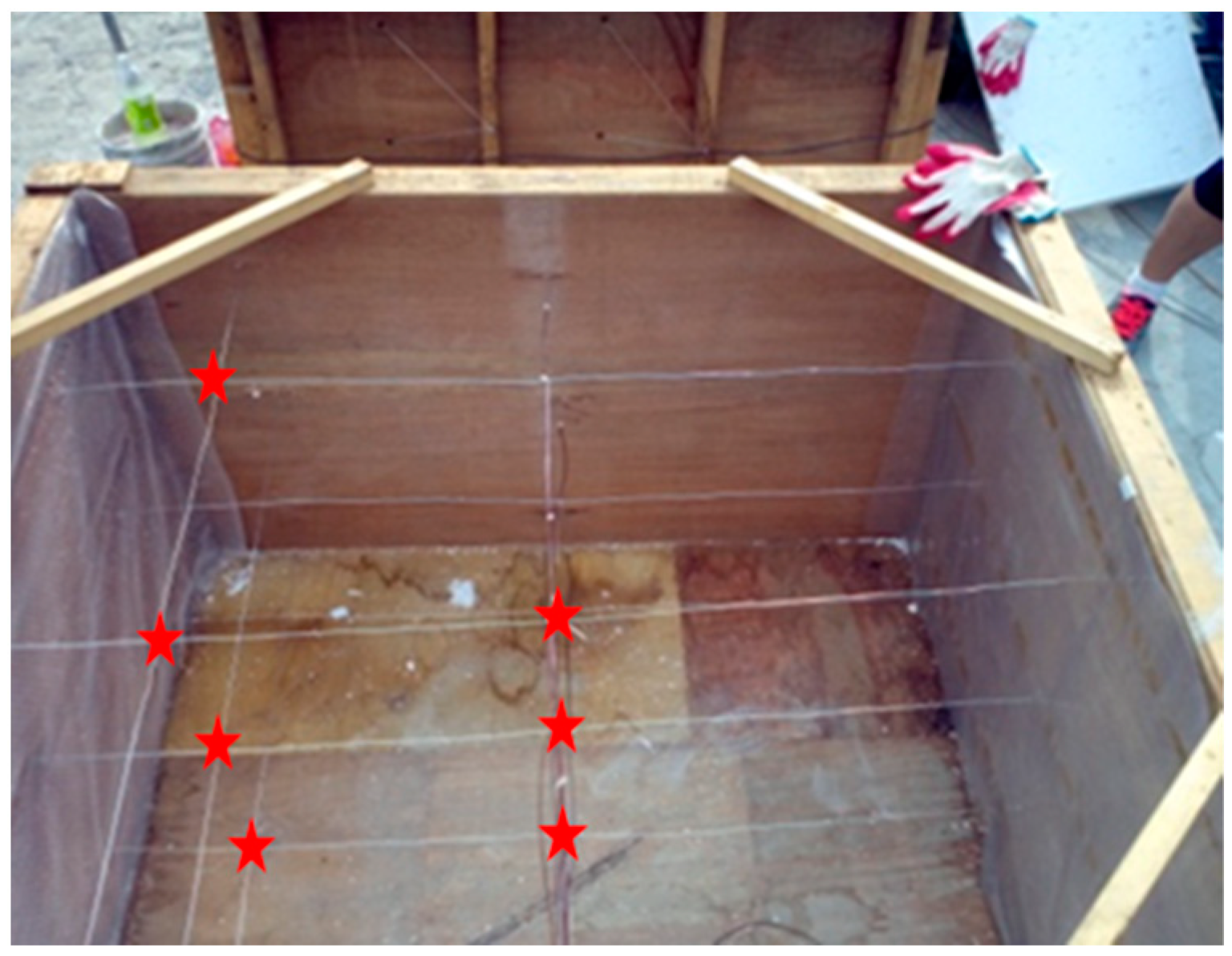
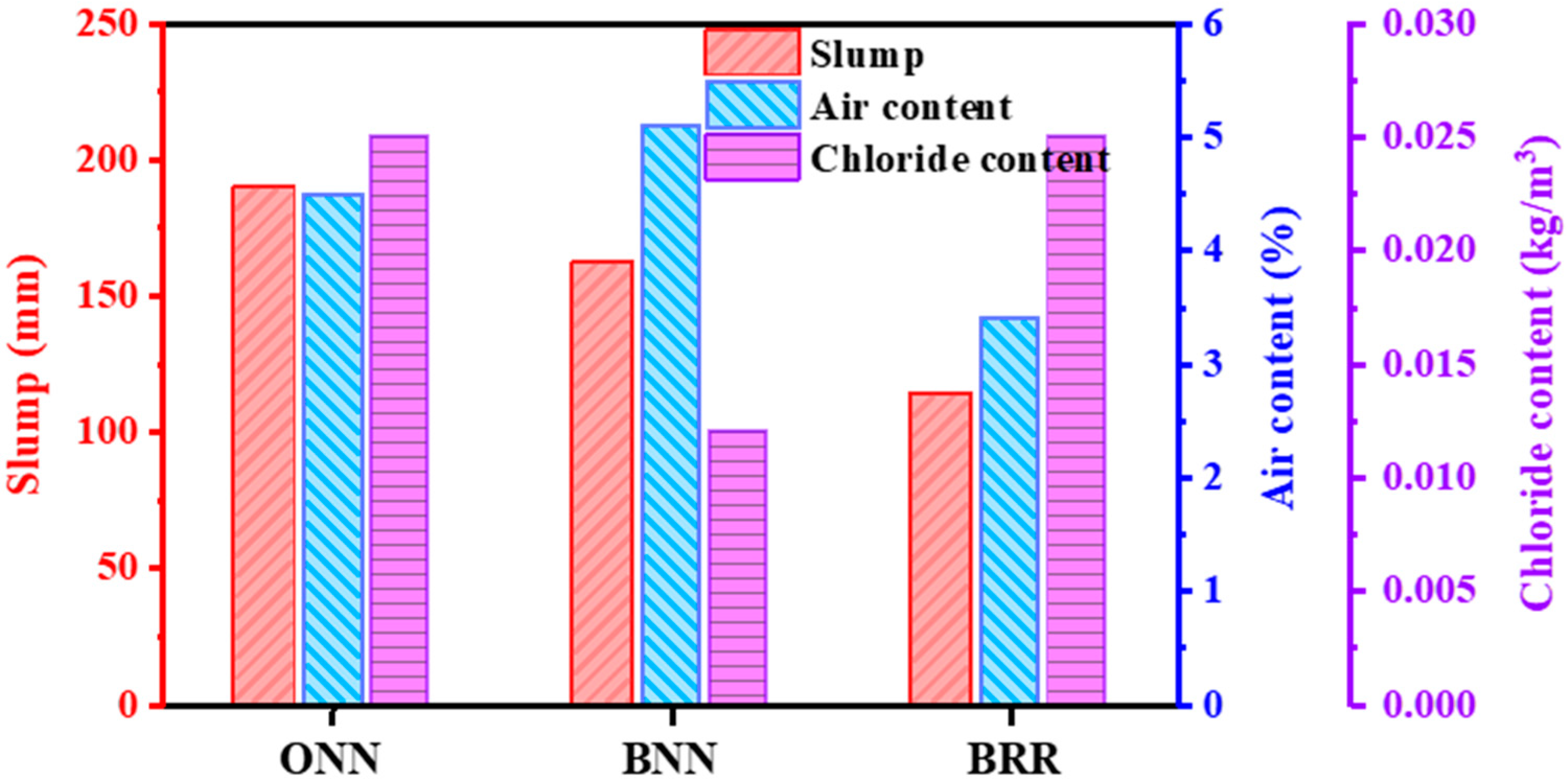
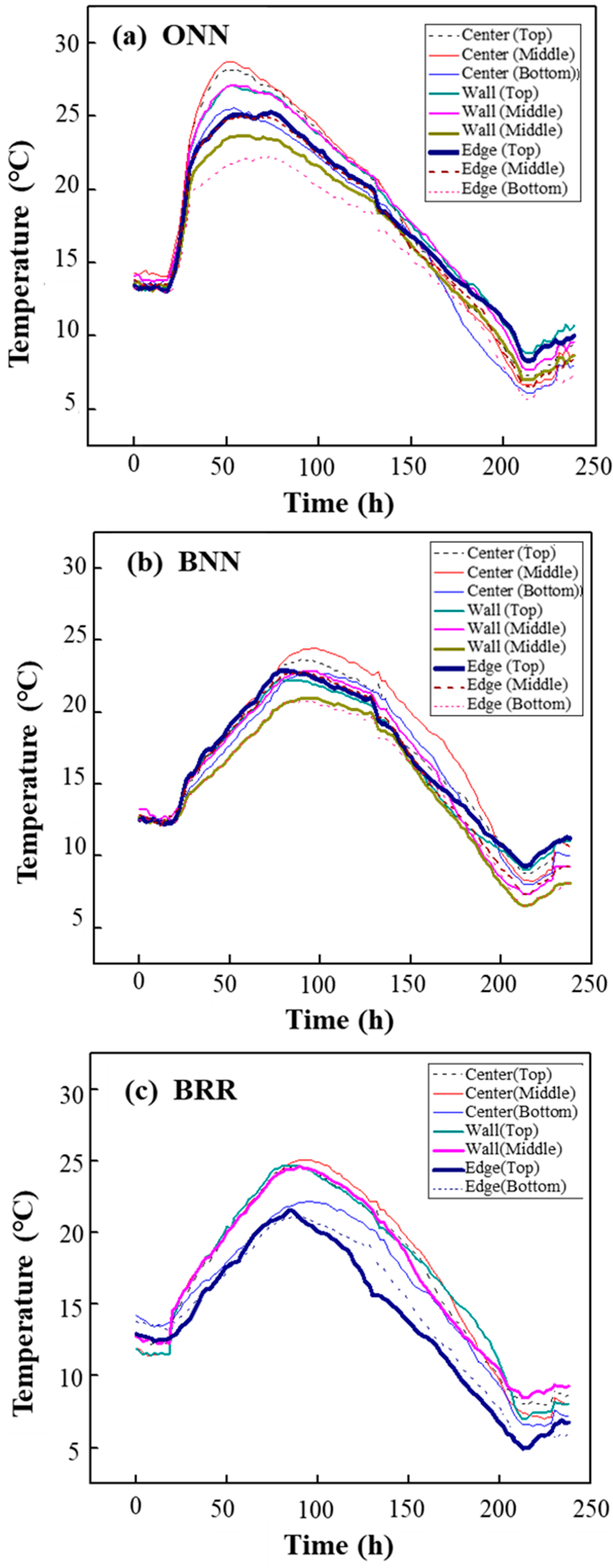

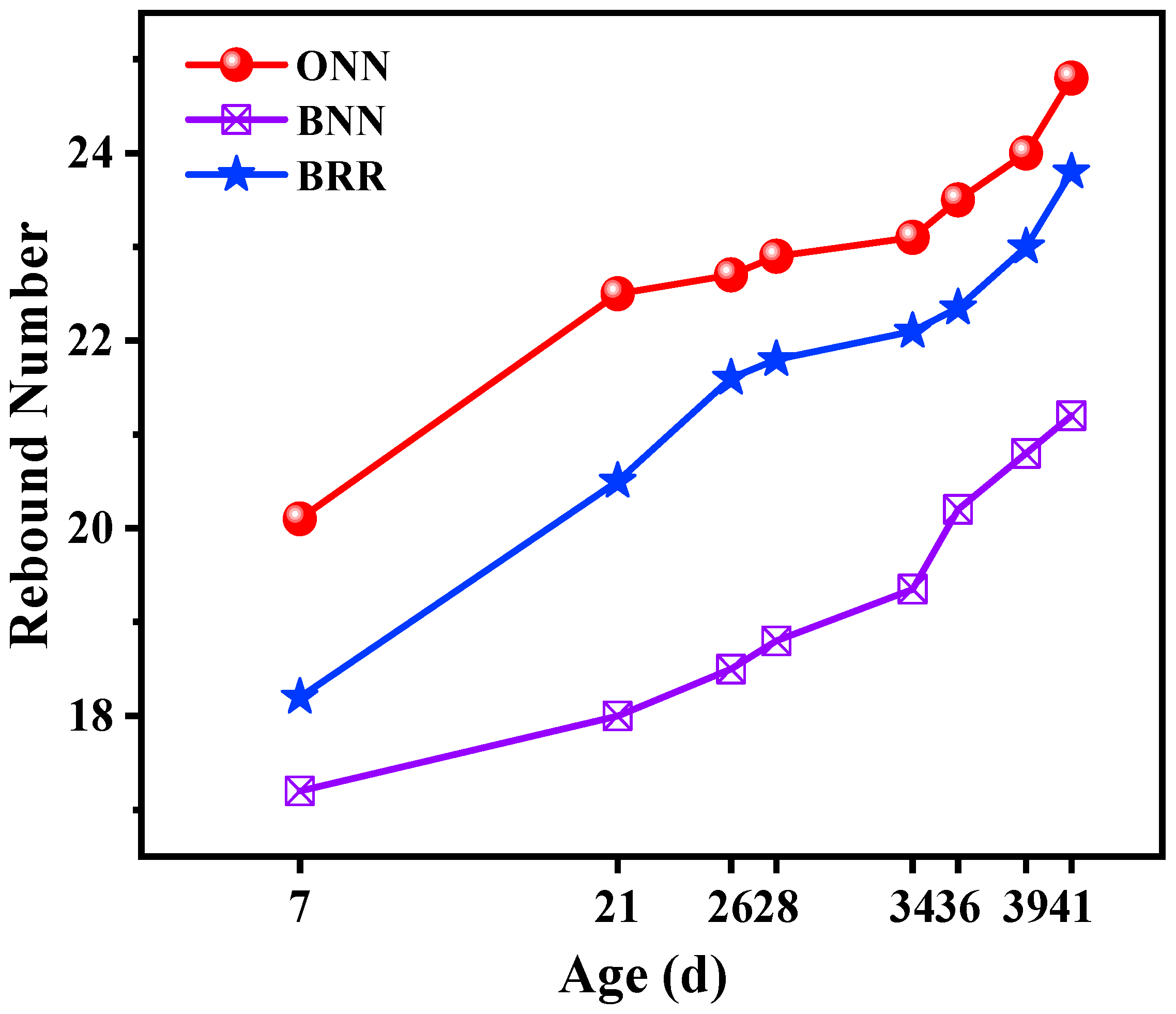
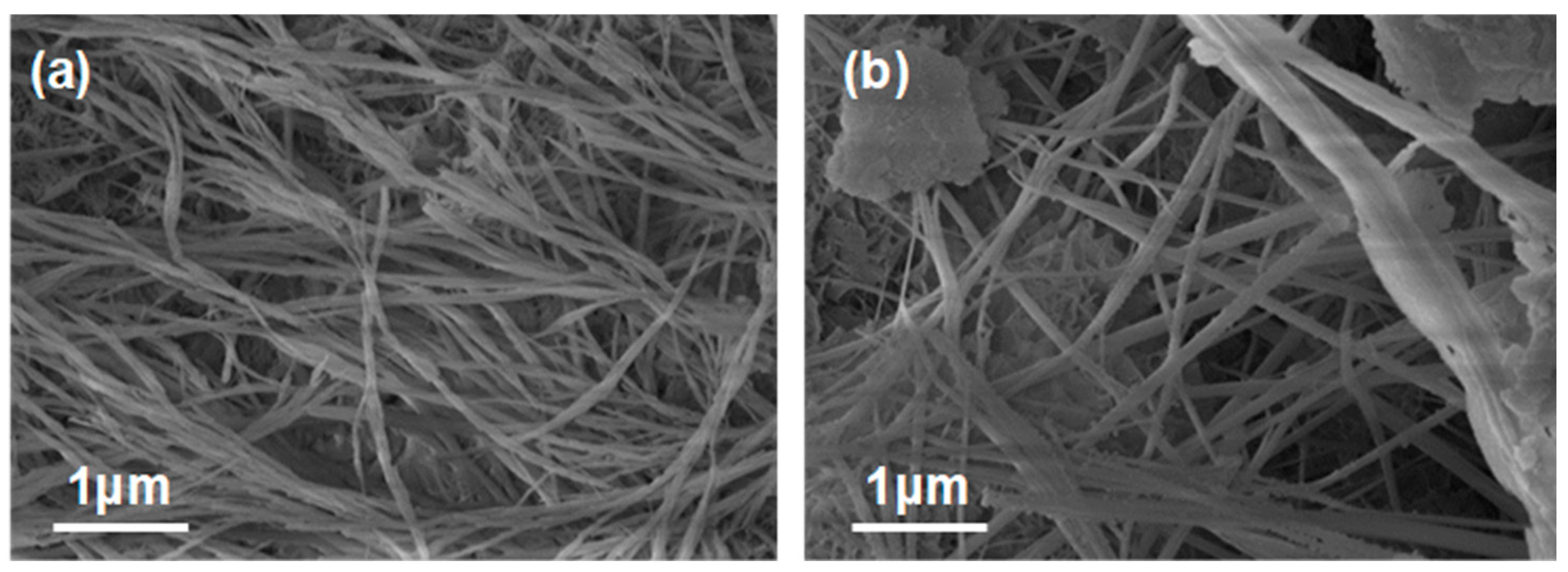
| Ingredients | SiO2 | Al2O3 | Fe2O3 | CaO | MgO | Others |
|---|---|---|---|---|---|---|
| OPC | 21.4 | 5.45 | 3.5 | 64.48 | 1.46 | 3.71 |
| GGBFS | 27.6 | 13.51 | 0.54 | 42.96 | 9.31 | 6.08 |
| Aggregate | Physical Properties | Chemical Composition (wt. %) | |||||||||
|---|---|---|---|---|---|---|---|---|---|---|---|
| Fineness Modulus | Water Absorption (%) | Density (g/cm3) | SiO2 | CaO | Al2O3 | Na2O | K2O | MgO | Cl− | Others | |
| RCA | 6.14 | 4.20 | 2.65 | 73.62 | 9.12 | 7.48 | 0.96 | 1.17 | 3.58 | 0.74 | 3.33 |
| RFA | 2.76 | 6.20 | 2.58 | 60.40 | 16.96 | 10.65 | 1.87 | 3.10 | 1.00 | 0.13 | 5.89 |
| NCA | 6.48 | 0.58 | 2.76 | 96.71 | 0.23 | 0.63 | 0.08 | 0.14 | 0.24 | 0.01 | 1.96 |
| NFA | 2.86 | 2.63 | 2.69 | 75.59 | 1.39 | 13.18 | 3.28 | 4.42 | 0.11 | 0.02 | 2.01 |
| Mixture ID | OPC | GGBFS | Coarse Aggregate | Fine Aggregate | Water | ||
|---|---|---|---|---|---|---|---|
| Gravel | Recycled | River Sand | Recycled | ||||
| ONN | 360 | 0 | 1027 | - | 775 | - | 180 |
| BNN | 90 | 270 | 1027 | 775 | 180 | ||
| BRR | 90 | 270 | - | 1000 | - | 755 | 180 |
Disclaimer/Publisher’s Note: The statements, opinions and data contained in all publications are solely those of the individual author(s) and contributor(s) and not of MDPI and/or the editor(s). MDPI and/or the editor(s) disclaim responsibility for any injury to people or property resulting from any ideas, methods, instructions or products referred to in the content. |
© 2023 by the authors. Licensee MDPI, Basel, Switzerland. This article is an open access article distributed under the terms and conditions of the Creative Commons Attribution (CC BY) license (https://creativecommons.org/licenses/by/4.0/).
Share and Cite
Huo, Y.; Huang, J.; Han, X.; Sun, H.; Liu, T.; Zhou, J.; Yang, Y. Mass GGBFS Concrete Mixed with Recycled Aggregates as Alkali-Active Substances: Workability, Temperature History and Strength. Materials 2023, 16, 5632. https://doi.org/10.3390/ma16165632
Huo Y, Huang J, Han X, Sun H, Liu T, Zhou J, Yang Y. Mass GGBFS Concrete Mixed with Recycled Aggregates as Alkali-Active Substances: Workability, Temperature History and Strength. Materials. 2023; 16(16):5632. https://doi.org/10.3390/ma16165632
Chicago/Turabian StyleHuo, Yanlin, Jinguang Huang, Xiaoyu Han, Huayang Sun, Tianan Liu, Jingya Zhou, and Yingzi Yang. 2023. "Mass GGBFS Concrete Mixed with Recycled Aggregates as Alkali-Active Substances: Workability, Temperature History and Strength" Materials 16, no. 16: 5632. https://doi.org/10.3390/ma16165632




